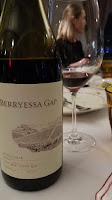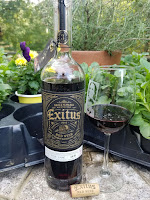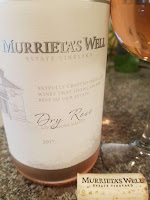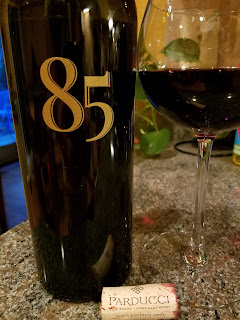We have been fans of
Foppiano Vineyards since we tasted there wines and heard their unique history at the
2007 Washington D.C. Food & Wine Festival. For Foppiano Vineyards is Sonoma County's oldest continually owned family winery, having operated since 1896. Thus, we made sure we started our day at this historical site. After emigrating from Genoa, Italy, Giovanni Foppiano failed to strike it rich mining for gold, so instead he purchased a working winery and started supplying wine to Italian families locally and in San Francisco. His son, Louis A. Foppiano, joined the operation and eventually purchased the franchise in 1910. Apparently father and son had differing visions. During the next decade, the winery flourished and the vineyard expanded as new grapes were planted. One of these was Petite Sirah, which would become the winery’s trademark wine. Then Prohibition hit. Since individual could still make 200 gallons of homemade wine, Foppiano stayed in business by shipping grapes east and by switching to other fruit for the local market. The winery retained its previous vintages and probably supplied the black market. But 6 years into Prohibition, the Feds finally realized the winery continued to posses wine and raided the facility. They released 100,000 gallons of the 1918 vintage into the neighboring creek. Since it was still lawful to consume wine, people from miles around raced to collect the wine for personal use. By this time Louis J. Foppiano had ascended the mantle after Louis A. passed in 1924. The Foppiano tasting room contains a picture of Louis J. sitting under a Federal Agent next to the creek, with one wine consumer passed out on the other side of the red river. When the Volstead Act and prohibition were repealed in 1933 Louis J, resumed operations and headed east in search of new markets and distribution channels. His efforts succeeded and by “1941, Foppiano Vineyards was sending six rail cars a week to the east coast filled with wine, and increased its production to over 800,000 gallons of wine annually.” The winery sells a miniature Lionel version of one of these rail cars – which we added to our train collection. A few years later Louis J. helped create the Sonoma County Wine Growers Association as California started gaining a winemaking identity. After conquering the jug wine market in the 1950’s the winery switched to more premium grapes as growers in the Central Valley were more cost competitive. New grapes were planted in the vineyard, with only the Petite Sirah remaining. From that time, Foppiano has slowly gained recognition for producing premium red wines and their Petite Sirah “is known nationwide as one of the country's top Petites year-in and year-out’. Louis J. passed the helm to son Louis M. and today, in his 90’s still resides near the winery. Louis M. shares he family affection for the Petite Sirah and was one of the leaders in forming the PS I Love You, Petite Sirah advocacy organization. With his sister, Susan Foppiano Valera, he plans to continue this family legacy into the next century.
When we arrived at 10:00 – yes they open that early for tasting – the winery was busy bottling and cleaning. A few other visitors were also trickling through, but the tasting room was relatively free so that the tasting room representative could give us his complete attention. We skipped the Pinot Gris and headed straight to the 2006 Russian River Valley Pinot Noir. This is a jammy cherry wine throughout, with a slightly toasty finish. This would be an interesting wine to compare with a Willamette Valley Pinot. Next up was the 2004 Russian River Valley Merlot. This is a full bodied wine – with more of a blackberry flavor than cherry. Vanilla is very noticeable at the finish. One of our favorites was the Lot 96 Bin 002 NV; a blend of Sangiovese, Petite Sirah, Zinfandel, Carignane, Merlot, Cabernet Sauvignon, and Cabernet Franc. This is a smooth fruity wine and priced at $12, this is a great value everyday drinking wine. The 2004 Russian River Valley Cabernet Sauvignon was similar to the Merlot in body and at the finish – although a little spicier at the tale. We last tried the 2005 Russian River Valley Petite Sirah – and again more blackberry than cherry. The most interesting part is the slight chocolate flavor at the finish. We thought we were through, but then the tasting room representative announced to the room, “Happy early 4th – here’s a library tasting of our Petite Sirah”. We tried the 2001 Russian River Valley Estate, 1988 Sonoma County Petite Sirah, and the 1994 Russian River Valley Estate Petite Sirah. What a bonus. The wines were still full bodied but incredibly smooth; with the 1994 Estate wine being our favorite of the three. We were getting ready to leave when Louis M. Foppiano volunteered to walk us through the vineyard – discussing the family history and showing off the Petite Sirah vines. What a great visit; thanks to everyone at Foppiano Vineyards.
Leaving Foppiano, we headed a couple miles south on Old Redwood Highway to
J Vineyards and Winery. This winery was founded by Judy Jordan, whose family also founded
Jordan Vineyard & Winery. J Vineyards is known for their sparkling wines so we were eager to visit. Entering the winery is also a bit confusing since they share a driveway with
Rodney Strong Vineyards. Just look for the signs. The grounds and tasting room were quite impressive which created a new concern as we worried how they would react to our son being present. This concern quickly dissipated when our tasting represented pulled out a can of apple juice, animal crackers, and a miniature wine bottle filled with. Boy, is this winery prepared for children. Thank goodness. Although we don’t really get modern design and architecture – J Vineyards tasting room was comfortable – even with this style. The design behind the tasting bar was especially interesting.
With our son occupied with food and bubbles, we started tasting, beginning with the sparkling wines. These wines are made “Methode Champeniose” where they sit, not 2 or 3, but 4 years on lees. The result is awesome sparkling wine - tiny bubbles, fruit flavors - nice acidity. We tasted the J Cuvee 20 (in honor of their 20th anniversary), the J Brut Rose, and the 1999 J Vintage Brut. The last was our favorite, made from Russian River Chardonnay. These wines are slightly pricey ranging from $30-$50 – but well within the range for excellent sparkling wines. Changing to white still wines, their J Chardonnay Russian River Valley is one of the few oaked chardonnay wines that we have tasted. It’s creamy, with good texture – but not overly buttery. The fruit still dominates. Our favorite white was the J Viognier Alexander Valley. We tried both the 2006 and 2007 vintages and noticed several distinctions between the two which makes it interesting to taste a vertical series. The 2007 is fruitier with a vanilla finish, whereas the 2006 is creamier. Both are excellent.
Moving to reds, J Vineyards offers several Pinot Noirs, a Zinfandel, and even a Pinotage. The latter was a good interpretation of the variety. The wine was slightly smoky, but not to the extremes as made in South Africa. Sometimes with these versions you wonder if you are drinking a coastal Scotch. The Zinfandel was also different than the spicy versions made in Amador and Lodi – its fruit forward with a blackberry flavor and slightly vanilla finish. Finally, the Pinots were very good. The Russian River Pinot Noir is a blend from 5 vineyards and interestingly the nose is very peppery – but not the flavor or finish. Instead you get cherry. We next tried the J Pinot Noir Nicole’s Vineyard which our rep described as masculine and the J Pinot Noir Robert Thomas Vineyard which she described as feminine. We agreed with her assessment, but for some reason preferred the Thomas Vineyard version.
We ended our session by tasting the J Ratafia dessert wine; a blend of several varieties included Pinot Meunier and fortified with brandy. This is a great dessert wine – it tastes like peaches and apricots with a nutty finish. And this was one of only three wines that we purchased the entire trip. J Vineyards was extremely accommodating during our entire visit – which probably lasted over an hour and a half - just in the tasting room. If you are traveling to Sonoma with children, this is one winery you must visit. And for those without children, come to sample and excellent array of sparkling and still wines.
Our final winery visit of the day was to
Limerick Lane Cellars, the only American producers of Furmint wine. The winery has also built a respectful reputation producing zinfandel wines. Plus, Limerick Lane is located in the same southern Healdsburg local as the first two wineries. The winery started over twenty years ago when Michael and Tom Collins and their friend Ted Markoczy, purchased a run down 30 acre vineyard on Limerick Lane. They resuscitated the existing vines, planted new vines and razed and cleared land for a new winery. After producing a Sauvignon Blanc wine at a custom crush facility, they decided to concentrate on the variety best suited for their terrior: Zinfandel. Their first vintage was bottled in 1993 and immediately recognized as an “an exemplar of the finest California Zinfandel”. In the meantime Michael Collins also travelled to the Tokaj region in Hungary and returned with Furmint and Hárslevelu cuttings. The results of this endeavor is posted
here, but needless to say we were excited to try their Furmint wine.
When we arrived we were fortunate that winemaker, Ross Battersby, was pouring wines that afternoon. Mr. Battersby joined Limerick Lane in 1997 after working at Stonestreet Winery. There are not many in Sonoma with his interested background either. The U.K. native has an Honors degree in Agricultural Economics, worked as a safari guide in Africa, and moved to Berkeley to manage an international adventure travel company. That proximity to Sonoma and Napa raised his interest in wine and many years later we meet him at Limerick Lane.
We started the tasting with the zinfandel, the Collins Vineyard Deco Zin and the Collins Vineyard Zinfandel. Both were produced in the Russian River Valley style that we have come to appreciate on this trip: fruit forward cherry and raspberry flavors with just a hint of vanilla. And completely smooth. The difference between the two is that the Collins Vineyard Zinfandel is a blend of Zinfandel grapes from throughout the estate with the average age of the vines being about 50 years. On the other hand the Deco Zin is produced from a lot of 74 year old vines. Some of the grapes from this lot also go into the Collins Vineyard Zinfandel – but the initial selection comprises the Deco Zin. We have become complete converts to Russian River Valley Zindandel. And also Russian River Valley Pinot Noir. Limerick Lane produces their version, the Orsi Vineyard Pinot Noir. If you prefer the big bold, high alcohol pinot noirs, this wine is not for you. Instead it is medium bodied – and I hate to use the adjective – but silky smooth and somewhat earthy. A European wine. The winery also produces a European style dry rose in the Rose Sec. This is a 50-50 blend of Zinfandel and Syrah – also from estate grown grapes. The wine has a strawberry flavor and out of the few rose styled wines offered on our trip, this was one of the best.
We finally came around to the NV Late Harvest Furmint a blend of the 2002- 2004 vintages. The wine is made in the Tokaji Aszu fashion at approximately 3 puttonyos – with 6 puttonyos the sweetest. Please see
Dezel's Virginia Vine Spot for another good overview of Tokaji Aszu. The wine was golden as expected and tasted just like the Hungarian version: apricots and honey. The one difference is that Limerick Lane’s version has a slightly nutty finish – whereas the last Tokaji Oremus Aszu 5 puttonyos that we tasted was all apricot from start to finish. Look for a later posting for a live comparative tasting between Limerick Lane’s NV Late Harvest Furmint and a couple Hungarian 3 puttonyos dessert wines.
Limerick Lane Cellars is a must visit for any tourist to Sonoma County. For one, there is no place in the United States where you can taste a Furmint wine and perhaps their dry Furmint would be available during your visit. Their Zinfandel wines are outstanding as well and the Rose and Pinot Noir. Apparently their Syrah is not too shabby either. Plus the staff, as displayed by Mr. Battersby, are extremely courteous and entertaining. Traveling with children. You should see how quickly their winemaker fixed broken Kung Fu Panda chopsticks using a cork and a rubber band.
See the
Compass Tours section at
Wine-Compass.com for pictures.



































